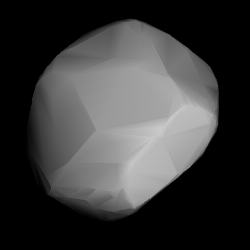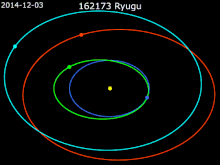
225 Henrietta is a very large outer main-belt asteroid. It was discovered by Austrian astronomer Johann Palisa on April 19, 1882, in Vienna and named after Henrietta, wife of astronomer Pierre J. C. Janssen. The asteroid is orbiting at a distance of 3.39 AU from the Sun with a period of 6.24 years and an eccentricity (ovalness) of 0.26. The orbital plane is inclined at an angle of 20.9° to the plane of the ecliptic. 225 Henrietta belongs to Cybele group of asteroids and is probably in a 4:7 orbital resonance with the planet Jupiter.

Hypatia is a very large main-belt asteroid that was discovered by Russian astronomer Viktor Knorre on July 1, 1884, in Berlin. It was the third of his four asteroid discoveries. The name was given in honour of philosopher Hypatia of Alexandria. Based upon the spectrum, it is classified as a C-type asteroid and is probably composed of primitive carbonaceous material. Like many asteroids of this type, its surface is very dark in colour.

Tyche is a relatively large main belt asteroid discovered by Robert Luther at Düsseldorf-Bilk Observatory on 4 May 1886. The stony S-type asteroid measures about 65 kilometers in diameter and has a perihelion of 2.1 AU.

Libussa is a Main belt asteroid that was discovered by C. H. F. Peters on December 22, 1886, in Clinton, New York and was named after Libussa, the legendary founder of Prague. It is classified as an S-type asteroid.
Hungaria is a relatively small asteroid orbiting in the inner asteroid belt. It is an E-type (high-albedo) asteroid. It is the namesake of the Hungaria asteroids, which orbit the Sun on the inside of the 1:4 Kirkwood gap, standing out of the core of the asteroid belt.

832 Karin is a minor planet orbiting the Sun. It is the largest and brightest member of the Karin Cluster, which is named after it. Found in 2002, the Karin cluster is notable for being very young. It is currently believed to have formed in a collision only 5.8 million years ago.
985 Rosina, provisional designation 1922 MO, is a stony asteroid and sizable Mars-crosser on an eccentric orbit from the inner regions of the asteroid belt, approximately 8 kilometers in diameter. It was discovered on 14 October 1922, by astronomer Karl Reinmuth at the Heidelberg-Königstuhl State Observatory in Germany. The asteroid's name is a common German female name, unrelated to the discoverer's contemporaries.
1155 Aënna, provisional designation 1928 BD, is an asteroid from the inner regions of the asteroid belt, approximately 11 kilometers in diameter. It was discovered on 26 January 1928, by German astronomer Karl Reinmuth at Heidelberg Observatory in southwest Germany. It is named for the astronomy journal Astronomische Nachrichten.
1157 Arabia, provisional designation 1929 QC, is an asteroid from the outer regions of the asteroid belt, approximately 29 kilometers in diameter. Astronomer Karl Reinmuth discovered it at the Heidelberg Observatory in southwest Germany on 31 August 1929. The asteroid was named for the Arabian Peninsula.
2751 Campbell, provisional designation 1962 RP, is a stony Nysian asteroid from the inner regions of the asteroid belt, approximately 6 kilometers in diameter.
6470 Aldrin, provisional designation 1982 RO1, is a stony Flora asteroid from the inner regions of the asteroid belt, approximately 3 kilometers in diameter.
5642 Bobbywilliams, provisional designation 1990 OK1, is an eccentric, stony asteroid and Mars-crosser from the inner regions of the asteroid belt, approximately 4.7 kilometers in diameter.
3034 Climenhaga is a stony Florian asteroid and synchronous binary asteroid from the inner regions of the asteroid belt, approximately 7.8 kilometers in diameter. The asteroid was discovered on 24 September 1917 by German astronomer Max Wolf at Heidelberg Observatory in southwest Germany and assigned provisional designation A917 SE. It was later named after Canadian astrophysicist John Climenhaga. Its minor-planet moon has a period of nearly 19 hours.
2754 Efimov, provisionally named 1966 PD, is a stony asteroid and binary system from the inner regions of the asteroid belt, approximately 5 kilometers in diameter. It was discovered on 13 August 1966, by Russian astronomer Tamara Smirnova at the Crimean Astrophysical Observatory in Nauchnyj, on the Crimean peninsula. The asteroid was named after Russian aviator Mikhail Efimov.
4435 Holt, provisional designation 1983 AG2, is a stony asteroid, sizable Mars-crosser and binary system from the inner regions of the asteroid belt, approximately 5 kilometers in diameter. It was discovered on 13 January 1983, by American astronomer Carolyn Shoemaker at the Palomar Observatory in California, United States. It was later named after American astronomer Henry E. Holt. The discovery of its companion was announced in January 2018.
9069 Hovland, provisional designation 1993 OV, is a stony binary Hungaria asteroid from the inner regions of the asteroid belt, approximately 3 kilometers in diameter.
12482 Pajka, provisional designation 1997 FG1, is a background asteroid from the inner regions of the asteroid belt, approximately 4.3 kilometers in diameter. It was discovered by Slovak astronomers Adrián Galád and Alexander Pravda at Modra Observatory on 23 March 1997. It was named after Paula Pravdová ("Pajka"), the daughter of the second discoverer.
3963 Paradzhanov, provisional designation 1969 TP2, is a Nysian asteroid from the inner regions of the asteroid belt, approximately 6 kilometers in diameter. It was discovered on 8 October 1969, by astronomer Lyudmila Chernykh at the Crimean Astrophysical Observatory in Nauchnyj, on the Crimean peninsula. The asteroid was named after Soviet film director Sergei Parajanov (Sargis Paradzhanov) in 1996.
13732 Woodall, provisional designation 1998 RC56, is a stony Vestian asteroid from the inner regions of the asteroid belt, approximately 4 kilometers in diameter. It was discovered on 14 September 1998, by the Lincoln Near-Earth Asteroid Research (LINEAR) team at Lincoln Laboratory's Experimental Test Site in Socorro, New Mexico.
2623 Zech, provisional designation A919 SA, is a stony binary asteroid from the inner regions of the asteroid belt, approximately 6.5 kilometers in diameter. It was discovered on 22 September 1919, by German astronomer Karl Reinmuth at Heidelberg Observatory in southwest Germany. It was named after German ARI astronomer Gert Zech.






